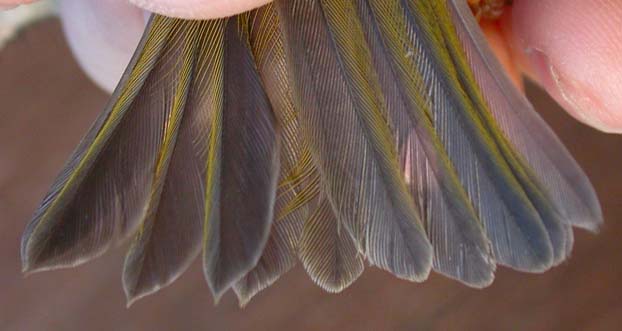Retraps, large and small (7 November 2004)
Some ringers do not like retraps, birds already wearing rings. However, they can often be amongst the most fascinating birds that we catch. One of the advantages of having birds individually marked through ringing is that an individual can be studied at different times of its life. The female Sparrowhawk Accipiter nisus with ring number ET30311 was recaptured recently at Norton Priory, Cheshire: this same bird has featured previously on these pages.
.jpg)
The photograph on the right above was taken on her first capture, on 23 January 2003, and that on the left when she was recaptured on 7 November 2004. The previous webpage posting explained how she was aged as a bird hatched in 2001, so in the right-hand photo she is about eighteen months of age, and now is almost three and a half years old. As is often found, colours depend greatly on the light and the time of day, but it is noticeable that her iris colour does not seem to have changed much. The eye colour of many birds intensifies, usually with a higher proportion of red pigment occurring, as the bird gets older. The fact that this bird appears to have changed little between 1½ and 3½ years of age is typical of Sparrowhawks, as reported by Ian Newton in his book 'The Sparrowhawk' (1986, T & A D Poyser): 'the most consistent changes occurred between the first and second years ... In most females, the eyes remained yellow, even in the oldest individuals, though in a few they became pale orange.'
However, what appeared to be different from published information on Sparrowhawks is her plumage, especially the extent of interrupted moult. The photo of the left wing shows that secondaries 2, 3, 6 and 10 (counting from the centre of the wing towards the body) are grey and fresh while the rest of the secondaries are browner in colour and more worn. This was symmetrical, with an identical moult pattern on the right wing. This is perhaps a good time to remind ourselves that Sparrowhawks have 14 secondaries, the innermost four of which are the tertials. All raptors moult the secondaries from two or three centres, thus having only small gaps where the feathers are missing and enabling them to keep a high level of flight ability during their lengthy moult. It is, therefore, not surprising that the unmoulted feathers are not all adjacent.
.jpg)
ET30311 showed a similar effect on the tail. Rectrices 2 and 4 (counting from the centre of the tail outwards) are darker grey, with more white on the tips. This is also symmetrical, although only the outside edge of r4 on the right side is visible in this photo and it is still growing, with a few millimetres to go before reaching the full length. The outermost tail feathers appear to be in-between in colour, greyer than the adjacent r5 but not as dark and fresh as the new r2 and r4.
.jpg)
It appears from the literature that the occurrence of interrupted moult, especially as extensive as this, is unusual in Sparrowhawks, but this bird, along with the bird caught on 18 December 2003 and depicted elsewhere on these pages, makes me wonder if it is becoming more common.
One other feature of ET30311 that was commented upon previously is her small size, although measurement of her wing length showed that she had increased by 4mm. Again, this is typical of Sparrowhawks which, other studies have shown, increase significantly in wing length from their first to second to third year of age. But she certainly weighed much more on this occasion (230g on 23 January 2003, 306g on 7 November 2004). At least part of the reason for the increase in weight can be seen in the following photo, showing, from her bulging crop, that she had recently eaten:
.jpg)
At the other end of the size range is Britain's smallest bird, the Goldcrest Regulus regulus. One of the particular uses of retrap birds is that birds known to have been ringed in previous years can be used to establish ageing criteria, as examples of definite adults. Goldcrests are tricky to age, as discussed previously in these pages, because their usual moult limits are almost impossible to discern. The only ageing criterion given by Svensson (Identification Guide to European Passerines, 1992) for Goldcrest, after skull ossification is complete, is the shape of the tail feathers: broad and rounded for adults or narrow and pointed for first-years. The photograph below shows the tails of two Goldcrests ringed in 2003 at Norton Priory and retrapped on 7 November 2004.
.jpg)
Although both birds are adults, neither shows a classic 'adult' tail shape. They do not have the fine points that some first-year birds have, but neither do they have the rounded tips shown by some adults. Svensson depicts extremes of rectrix shape and urges caution: 'do not age intermediates between these two'. Both of these fall in his intermediate range.
Occasionally an especially helpful bird comes along, such as the first-year Goldcrest whose tail is depicted below, caught recently by fellow-ringers and MRG members on Hilbre Island. (Thanks to John Elliott and Colin Jones for the photograph of this bird.) This bird had accidentally lost half of its tail, and, as always happens, grown replacement feathers of the next generation. So, it has first-year rectrices - the outermost five on its left side and the outermost one on the right side - and 'adult' rectrices - the central pair and r2 to r5 inclusive on the right side - alongside each other, giving a direct comparison.

David Norman.